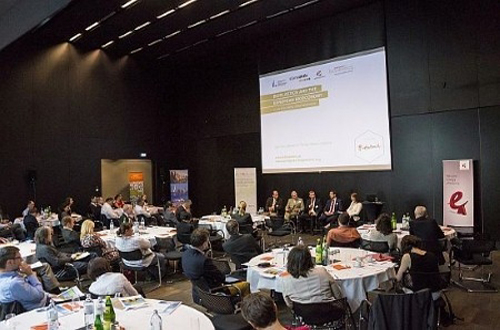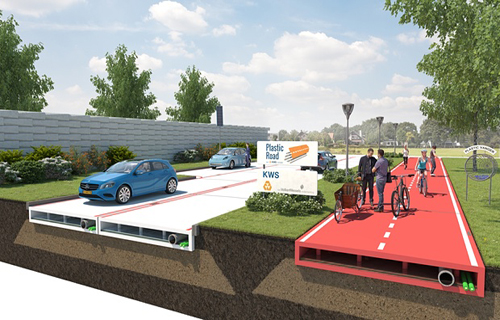The Coca-Cola Company has some news to share. The multinational beverage and snack manufacturer is shifting to 100% recycled polyethylene terephthalate (rPET) plastic bottles across its drink portfolio.
Beginning in February 2021, the company’s brands including Coke, Coke Zero Sugar, Diet Coke and Fanta will now come in a new, 13.2oz bottle designed to be sippable and reduce the amount of plastic used. Coca-Cola was first introduced in 1886 and has since become one of the most iconic, recognizable drinks in the world.
The shift to reduce plastics is part of the Atlanta-based company’s 2018 global goal to create a World Without Waste, says Alpa Sutaria, vice president and general manager of sustainability for Coca-Cola’s North America Operating Unit. The company aims to make 100% of its packaging recyclable by 2025 and to use 50% recycled content by 2030. The bottle redesign is a step forward to achieving this goal.
“Achieving a World Without Waste starts with design,” Sutaria says. “We design our bottles for recyclability and reuse so that when they are collected and recycled, they can have many lives including as new bottles and cans. We are actively developing a circular economy for our bottles and cans – by increasing our use of recycled materials. This reduces our use of virgin PET (plastic) and reduces the environmental impact of our packaging.”
The Coca-Cola Company has some news to share. The multinational beverage and snack manufacturer is shifting to 100% recycled polyethylene terephthalate (rPET) plastic bottles across its drink portfolio.
Beginning in February 2021, the company’s brands including Coke, Coke Zero Sugar, Diet Coke and Fanta will now come in a new, 13.2oz bottle designed to be sippable and reduce the amount of plastic used. Coca-Cola was first introduced in 1886 and has since become one of the most iconic, recognizable drinks in the world.
The shift to reduce plastics is part of the Atlanta-based company’s 2018 global goal to create a World Without Waste, says Alpa Sutaria, vice president and general manager of sustainability for Coca-Cola’s North America Operating Unit. The company aims to make 100% of its packaging recyclable by 2025 and to use 50% recycled content by 2030. The bottle redesign is a step forward to achieving this goal.
“Achieving a World Without Waste starts with design,” Sutaria says. “We design our bottles for recyclability and reuse so that when they are collected and recycled, they can have many lives including as new bottles and cans. We are actively developing a circular economy for our bottles and cans – by increasing our use of recycled materials. This reduces our use of virgin PET (plastic) and reduces the environmental impact of our packaging.”ADVERTISING
The company has been collaborating with partners such as The Recycling Partnership, The Closed Loop Fund and Keep America Beautiful to boost recycling across the United States. It recently invested more than $17 million in recycling programs and infrastructure and placed more than 1 million recycling bins across the country.
Waste360: How long has this plan been in development? What factors went into deciding the switch to new packaging, including consumer demand?
The Coca-Cola Company has some news to share. The multinational beverage and snack manufacturer is shifting to 100% recycled polyethylene terephthalate (rPET) plastic bottles across its drink portfolio.
Beginning in February 2021, the company’s brands including Coke, Coke Zero Sugar, Diet Coke and Fanta will now come in a new, 13.2oz bottle designed to be sippable and reduce the amount of plastic used. Coca-Cola was first introduced in 1886 and has since become one of the most iconic, recognizable drinks in the world.
The shift to reduce plastics is part of the Atlanta-based company’s 2018 global goal to create a World Without Waste, says Alpa Sutaria, vice president and general manager of sustainability for Coca-Cola’s North America Operating Unit. The company aims to make 100% of its packaging recyclable by 2025 and to use 50% recycled content by 2030. The bottle redesign is a step forward to achieving this goal.
“Achieving a World Without Waste starts with design,” Sutaria says. “We design our bottles for recyclability and reuse so that when they are collected and recycled, they can have many lives including as new bottles and cans. We are actively developing a circular economy for our bottles and cans – by increasing our use of recycled materials. This reduces our use of virgin PET (plastic) and reduces the environmental impact of our packaging.”ADVERTISING
The company has been collaborating with partners such as The Recycling Partnership, The Closed Loop Fund and Keep America Beautiful to boost recycling across the United States. It recently invested more than $17 million in recycling programs and infrastructure and placed more than 1 million recycling bins across the country.
In a Q&A with Waste360, Sutaria discusses The Coca-Cola Company’s sustainability initiatives.
Waste360: How long has this plan been in development? What factors went into deciding the switch to new packaging, including consumer demand?
Alpa Sutaria: In 2018, we announced ambitious goals to achieve a World Without Waste by collecting and recycling the equivalent of one bottle or can for each one we sell by 2030. We also pledged to make all of our packaging recyclable by 2025 and use 50% recycled content by 2030. The innovations that we’ve announced today are all part of our progress toward that goal.
Around the world, including in the United States, we deliver our beverages in a range of packaging including PET, aluminum, glass, refillable and packageless. We are exploring and expanding on all of these systems to ensure that The Coca-Cola Company is delivering refreshments to consumers in the most environmentally sustainable way. By rolling out this new suite of products made from 100% recycled materials* in our flagship market, we’re one step closer to achieving our goals to create a circular economy for our packaging.
Waste360:What is the process and timeline to rolling out the new bottles across all product lines?
Sutaria: Starting this month and rolling out over the next several months in California, the Northeast and Florida, our most iconic and biggest brand, Coca-Cola, will launch an all-new, 13.2oz bottle made from 100% recycled material (not including the bottle’s cap and label) – conveniently sized in a more sippable package while reducing our use of new plastic.
As part of a portfolio approach, starting this month and continuing throughout the year, we are also introducing 20oz bottles made with 100% recycled material* across Coca-Cola trademark and Diet Coke in California, New York and Texas. In addition, this summer, smartwater will be launching 20oz 100% rPET bottles* in New York and California, with DASANI available in these states plus Texas.
The bottles can be purchased at convenience retail stores, and will be available nationwide for consumers to purchase this summer. You can find an infographic of the overall timeline here.
Waste360: Were there any challenges to completely changing the packaging design while simultaneously making it more sustainable? If so, please explain.
Sutaria: Developing a new bottle made from 100% rPET was a challenge. It took us about 9 months to get to a point where we had designed a bottle that could not only meet the packaging performance required for a carbonated beverage, but also, once tested with consumers, we had a final product they were happy with. One of the biggest challenges in creating this bottle is procuring enough clean, food grade recycled plastic to be able to make enough of these sustainable bottles.
Waste360: What opportunities does this new design provide across its product lines?
Sutaria: The biggest opportunity is that our new packaging made with 100% recycled PET material* decreases our use of new plastic, decreases carbon emissions and accelerates progress towards our World Without Waste goals. Through our portfolio of 100% rPET packaging*, we are reducing the use of new plastic by more than 20% across the portfolio in North America compared to the amount of plastic used in 2018. Using internal company tools and analyses, it is estimated that this effort in the United States represents a 10,000 metric ton reduction in GHG emissions annually. This is the equivalent of taking 2,120 cars off the road for one year. Each of our 2021 actions gets us even closer to achieving our ambitious goals.
Waste360: Besides 100% recycled plastic (rPET), is Coca-Cola exploring any other materials including ones that are biodegradable?
Sutaria: We are determined to innovate and develop products and technologies that will minimize our collective impact on the environment. We are expanding the use of packageless solutions through the DASANI purefill and Coca-Cola Freestyle dispensed beverages. Around the world, we deliver our beverages in a range of packaging including PET, aluminum, glass, refillable and packageless. We are exploring and expanding on all of these systems to ensure that The Coca-Cola Company is delivering refreshments to consumers in the most environmentally sustainable way. We will continue to increase the use of recycled materials while innovating to develop products and technologies that will minimize our collective impact on the environment.






